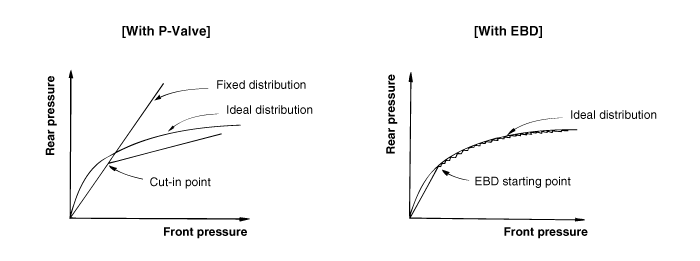 Hyundai Sonata: EBD(Electronic Brake-force Distribution). Description and Operation
Hyundai Sonata: EBD(Electronic Brake-force Distribution). Description and Operation
Operation
The EBD system (Electronic Brake force Distribution) as a sub-system of
the ABS system is to control the maximum braking effectiveness by the rear wheels.
It further utilizes the efficiency of highly developed ABS equipment by
controlling the slip of the rear wheels in the partial braking range.
The brake force is moved even closer to the optimum and controlled electronically,
thus dispensing with the need for the proportioning valve.
The proportioning valve, because of a mechanical device, has limitations
to achieve an ideal brake force distribution to the rear wheels as well as to
carry out the flexible brake force distribution proportioning to the vehicle
load or weight increasing. And in the event of malfunctioning, driver cannot
notice whether it fails or not.
EBD controlled by the ABS Control Module, calculates the slip ratio of
each wheel at all times and controls the brake pressure of the rear wheels not
to exceed that of the front wheels.
If the EBD fails, the EBD warning lamp (Parking brake lamp) lights up.
Advantages
| - |
Function improvement of the base-brake system.
|
| - |
Compensation for the different friction coefficients.
|
| - |
Elimination of the proportioning valve.
|
| - |
Failure recognition by the warning lamp.
|
Comparison between Proportioning Valve and EBD

 Troubleshooting
Troubleshooting
Failure Diagnosis
1.
In principle, ESC and TCS controls are prohibited in case of ABS
failure.
2.
When ESC or TCS fails, only the failed s ...
 ESC Control Module. Components and Components Location
ESC Control Module. Components and Components Location
Components
1. Front - left tube
2. Rear - right tube
3. Rear - left tube
4. Front - right tube
5. MC2
6. MC1
7. ESC control module(HECU)
8. Damper
9 ...
See also:
Tire specification and pressure label
The tires supplied on your new vehicle are chosen to provide the best performance
for normal driving.
The tire label located on the driver's side center pillar gives the tire pressures
re ...
Shift lock system
For your safety, the automatic transaxle has a shift lock system which prevents
shifting the transaxle from P (Park) or N (Neutral) into R (Reverse) unless the
brake pedal is depressed.
To shift ...
Hazardous driving conditions
When hazardous driving conditions are encountered such as water, snow, ice, mud,
sand, or similar hazards, follow these suggestions:
Drive cautiously and allow extra distance for braking.
...
